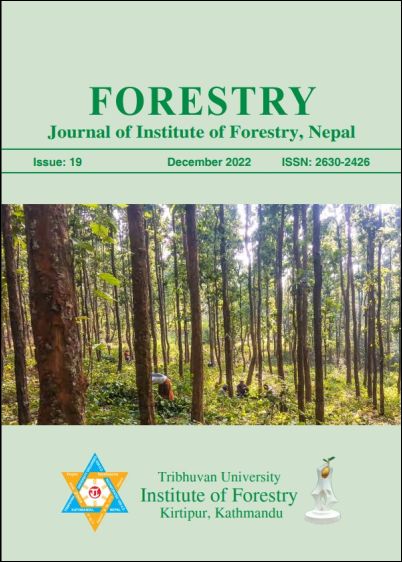An Assessment on Land Use Land Cover Mapping: Sentinel-2 Versus Landsat-9
DOI:
https://doi.org/10.3126/forestry.v19i01.55704Keywords:
LULC, Random forest, Google Earth Engine, Supervised classification, PokharaAbstract
Landuse is the human use of land and is inferred from land cover, which refers to the physical and biological cover on the surface of the land. Land use changes and impacts on land cover are key measures of environmental change caused by human activities, especially in rapidly developing areas. Information on such land use change patterns is required for sustainable development planning. Commencement of the Sentinel-2 satellite in mid-2015 and Landsat-9 satellite in late 2021 is opening new possibilities in Earth observation and monitoring through higher spatial, spectral, and temporal resolutions. Many researchers have been curious to compare improvements in these two satellites. This research tests the real difference in the quality of the results delivered by Sentinel-2 and Landsat-9 imagery when basic classification methods are applied. This study aims to assess the precision of the LULC classifications derived from Sentinel-2 and Landsat-9 data and to reveal which dataset presents greater accuracy. The Google Earth Engine (GEE) cloud computing platform was used, and the Pokhara metropolitan area was selected as the study area for this case study. The annual composite of Sentinel-2 Multispectral Instrument (MSI) and Landsat-9 Top-of-Atmosphere (TOA) reflectance, acquired for the period January 1, 2022 to August 31, 2022, was used as a satellite imagery in the study. The RGB and NIR bands of Sentinel-2 and Landsat-9 were used for classification and comparison. LULC images were generated using pixel-based supervised Random Forest machine learning algorithms for classification. In this study, the study area was classified into four land classes, i.e. Forest, Agriculture, Settlements, and Waterbodies. As a result of the accuracy assessment, the Kappa statistics for Sentinel-2 and Landsat-9 data were 0.78 and 0.72 respectively. The resultsobtained showed that Sentinel-2 MSI presents more satisfying LULC images than Landsat-9 TOA data. However, this situation can change if different statistics and classification methods are used.
Downloads
Downloads
Published
How to Cite
Issue
Section
License
© Tribhuvan University, Institute of Forestry




